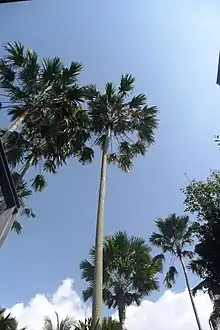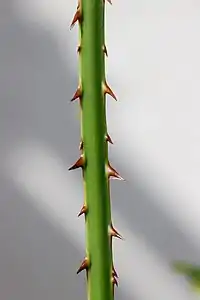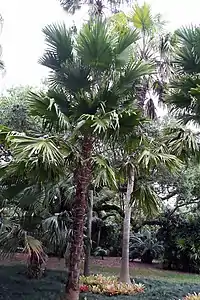Saribus rotundifolius
Saribus rotundifolius, also known as the footstool palm,[2][4][5] is a common fan palm found in Southeast Asia.[6] It is a member of the genus Saribus.[5][7]
| Saribus rotundifolius | |
|---|---|
 | |
| Saribus rotundifolius at the Nong Nooch Tropical Garden, Thailand | |
| Scientific classification | |
| Kingdom: | Plantae |
| Clade: | Tracheophytes |
| Clade: | Angiosperms |
| Clade: | Monocots |
| Clade: | Commelinids |
| Order: | Arecales |
| Family: | Arecaceae |
| Genus: | Saribus |
| Species: | S. rotundifolius |
| Binomial name | |
| Saribus rotundifolius | |
| Synonyms[2][3] | |
Common names
It is called anahaw or luyong in Filipino.[4] In Malay the palm is known as serdang daun bulat.[2]
Taxonomy
Saribus rotundifolius was first described as Corypha rotundifolia by the French Jean-Baptiste Lamarck in 1786.[8] It was moved to the Saribus genus by the German-Dutch botanist Carl Ludwig Blume in a publication issued in 1838 or 1839.[1] This move was generally not accepted by others in the field. In 2011, after DNA research, the reclassification from the Livistona genus to the resurrected genus Saribus was official.[7][9] The generic epithet Saribus comes from a local name in one of the Maluku languages, as recorded by the Dutch, sariboe.[10] The specific epithet means 'round-leaved' in Latin.[9]
Description
Saribus rotundifolius is a hermaphrodite fan palm.[2] The palm is evergreen, erect, and only grows having a single trunk ('solitary'). It grows at a height ranging from 15 to 25 metres,[11] exceptionally up to 45 metres tall,[2] and thickness of 15 to 25 cm diameter at breast height.[2][11] Its trunk is smooth and straight with a shallow rings of leaf scars.[11] The trunk is rather massive and tapering. It usually grows to 60 feet (18 m) tall, but may rarely reach 90 feet (27 m) tall. The young trees have a green crown. This species is seldom seen with a slight skirt of drooping, dead leaves. The sheaths are chestnut brown in colour.[9]
The palmately-lobed leaves are spirally arranged around the trunk. The petioles are long.[9][10] The entire leaf is some 1.2 metres in length. The leaf blade is entire in its centre,[9] and almost round in outline. It is regularly divided to about half of the length and 1.2 metres in diameter.[10] The leaf segments are forked, but not deeply, at their ends.[9] The leaf segments have one main nerve.[12]
The flowers are borne on an inflorescence with a long peduncle, about 0.9 to 1.2 metres long. The three-petalled flowers appear in bunches.[10]
The fruit is a fleshy drupe.[10] It is about 2cm in diameter,[9][10] quite round,[9] and coloured brick red as it ripens, ultimately becoming black when ripe.[9][10]
Distribution
The palm is native to Sulawesi and the Maluku Islands in Indonesia, and the Philippines. The native distribution stretches from Banggi Island in Sabah, Malaysia, off the north-east coastal tip of Borneo in the west, to the Raja Ampat Islands near Maluku off the north-west tip of Bird's Head Peninsula in Indonesia's West Papua province in the east. Its northernmost native distribution is in the Philippines.[3][5] It is abundant throughout the Philippines.[5] It has been introduced into the wild in Java, the Lesser Sunda islands, Peninsular Malaysia and Trinidad and Tobago.[3] It has also been introduced to India.[10]
On Java it occurs in the west and the central-eastern parts of the island. It is usually found as a cultivated plant, but already in the 1960s in some places it has escaped into the wild, becoming locally very numerous.[12]
Ecology
The lepidopteran caterpillars of the species Suastus gremius and Elymnias hypermnestra have been recorded using Saribus rotundifolius as a host plant.[13] The tree only flowers after it becomes very old. Its flowers are pollinated by bees.[10]
Uses
Saribus rotundifolius can be grown in humid, tropical areas. It is a common landscaping plant in the Philippines, and has been widely cultivated in Peninsular Malaysia, Singapore, Java and elsewhere, for a long time.[7][9][12] The fruit are quite attractive.[10] It is cultivated as an ornamental throughout Colombia.[3]
The leaves are used for the thatching of roofs and wrapping food. Overharvesting of the leaves of plants causes a reduction in leaf size. The leaves do grow faster after harvest but tend to be smaller.[6]
The foliage of the Saribus rotundifolius is the unofficial national leaf of the Philippines.[14]
Gallery

 Saribus rotundifolius in situ in Tangkoko Nature Reserve, Sulawesi
Saribus rotundifolius in situ in Tangkoko Nature Reserve, Sulawesi Saribus rotundifolius in a pot
Saribus rotundifolius in a pot Spines on margins of the petiole of a young plant of Saribus rotundifolius
Spines on margins of the petiole of a young plant of Saribus rotundifolius.jpg.webp) Saribus rotundifolius developing fruit
Saribus rotundifolius developing fruit Base of the trunk in Fairchild Tropical Botanic Garden, Miami
Base of the trunk in Fairchild Tropical Botanic Garden, Miami.jpg.webp) Trunk showing leaf scars in India
Trunk showing leaf scars in India However, the trunk is covered in persistent leaf bases for a long time
However, the trunk is covered in persistent leaf bases for a long time.jpg.webp) The disintegrating frond bases on the trunk of the palm
The disintegrating frond bases on the trunk of the palm
Conservation
This plant species is common and has been classed as 'least concern'.[5]
References
- "Saribus rotundifolius". International Plant Names Index. The Royal Botanic Gardens, Kew, Harvard University Herbaria & Libraries and Australian National Botanic Gardens. Retrieved 9 October 2020.
- "Saribus rotundifolius (Lam.) Blume - Arecaceae". Malaysia Biodiversity Information System (MyBIS). Ministry of Energy and Natural Resources (KeTSA). 2020. Retrieved 9 October 2020.
- "Saribus rotundifolius (Lam.) Blume". Plants of the World Online. Royal Botanic Gardens, Kew. 2017. Retrieved 9 October 2020.
- Marcial C. Amaro Jr., ed. (January–April 2010). "Anahaw" (PDF). Some Familiar Philippine Palms that Produce High Food Value and Tikog. Ecosystems Research and Development Bureau of the Philippine Department of Environment and Natural Resources. Archived from the original (PDF) on 2013-05-22. Retrieved 2013-04-01.
- "Saribus rotundifolius (Lam.) Blume, Rumphia 2: 49 (1838)". Palmweb. Botanischer Garten und Botanisches Museum Berlin, Royal Botanic Gardens, Kew and Aarhus University. 2013. Retrieved 9 October 2020.
- Johnson, Dennis V. (2010). "Tropical Palms - Asian region" (PDF). Non-wood forest products 10/Rev.1. Food and Agriculture Organization of the United Nations. Retrieved 2007-01-19.
- Bacon, Christine D.; Baker, William J. (2011). "Saribus resurrected". Palms. 55 (3): 109–116. Retrieved 10 October 2020.
- "Corypha rotundifolia". International Plant Names Index. The Royal Botanic Gardens, Kew, Harvard University Herbaria & Libraries and Australian National Botanic Gardens. Retrieved 9 October 2020.
- Whitmore, T.C. (1979). Palms of Malaya. 2nd impression (2 ed.). Petaling Jaya: Oxford University Press. p. 72. ISBN 0 19 580368X.
- "Saribus rotundifolius - Roundleaf Fountain Palm". Flowers of India. 2020. Retrieved 10 October 2020.
- Razal, Ramon; Palijon, Armando (2009). Non-Wood Forest Products of the Philippines. Calamba City, Laguna: El Guapo Printing Press. p. 27. ISBN 978-971-579-058-1.
- Backer, C. A.; Bakhuizen van den Brink, R. C. (1968). Flora of Java. III. Groningen: N.V. P. Noordhoff under auspices of Rijksherbarium, Leyden. pp. 173, 174.
- Churi, P. (2010). Kunte, K.; Sondhi, S.; Roy, P. (eds.). "Larval host plants — Livistona rotundifolius". Butterflies of India, v. 2.97. Indian Foundation for Butterflies. Retrieved 10 October 2020.
- Pangilinan, Jr., Leon (3 October 2014). "In Focus: 9 Facts You May Not Know About Philippine National Symbols". National Commission for Culture and the Arts. Retrieved 8 January 2019.